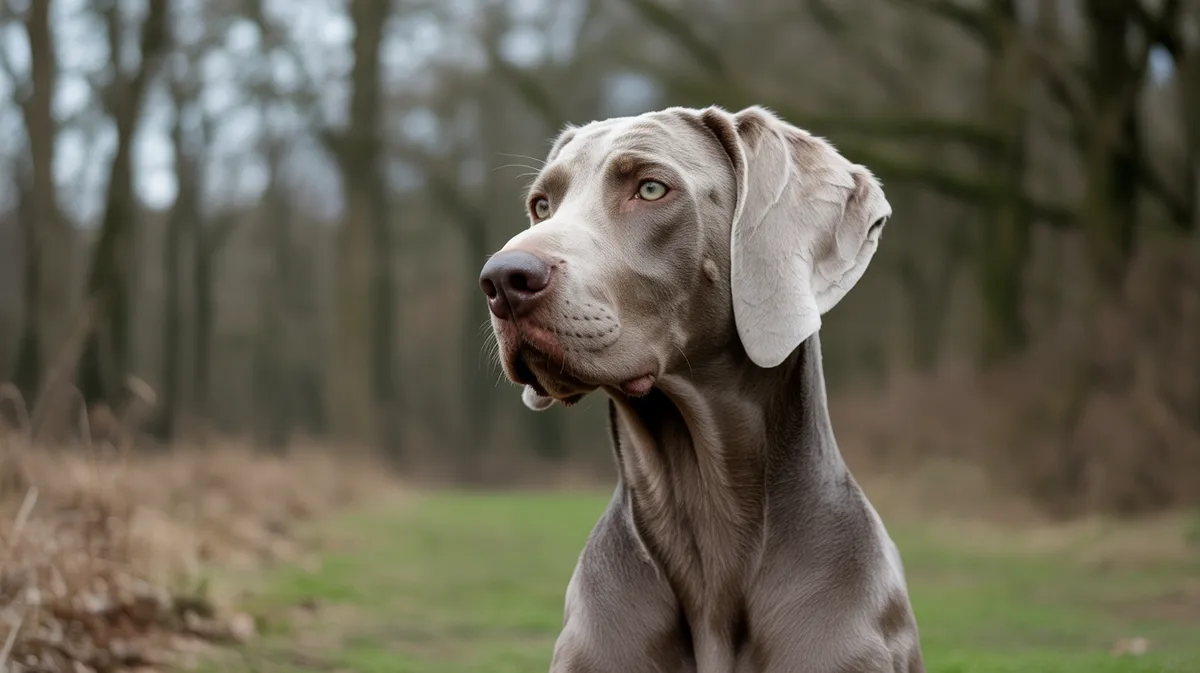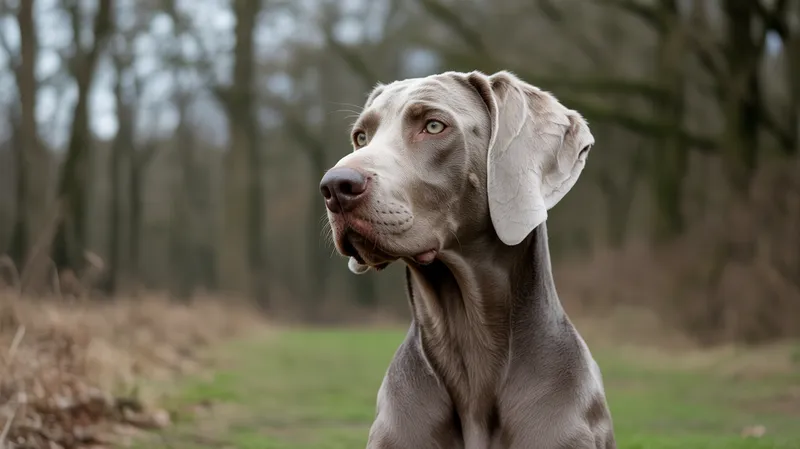
Weimaraner
Canis lupus familiaris

Meet the Weimaraner
The Weimaraner is a large, athletic breed of domestic dog originally developed in Germany for hunting big game such as deer and boar. Known for their sleek, short silver-gray coat and striking light eyes, Weimaraners are energetic, intelligent, and highly trainable. They thrive on companionship and physical activity, making them excellent partners for active families and outdoor enthusiasts. Their keen sense of smell and high stamina have also made them popular in search and rescue, as well as various dog sports.
Classification
Mammal
Habitat
Domestic; originally bred for forests and grasslands
Diet
Carnivore
Lifespan
10-13 years
Conservation
Least Concern
Weight
25–40 kg (55–88 lbs)
📖Fascinating Facts
Striking Eyes
Weimaraners are famous for their pale, light-colored eyes that range from gray to blue or amber.
Versatile Working Dog
Originally bred for hunting, Weimaraners now excel in various roles including search and rescue, therapy work, and dog sports.
High Energy
This breed requires significant daily exercise and mental stimulation to prevent boredom and destructive behavior.
📋Detailed Description
The Weimaraner is a medium to large-sized sporting dog, characterized by its lean, muscular build and distinctive short, sleek silver-gray coat, which provides minimal protection from cold but allows for agility and speed in the field. Adults typically stand 59–70 cm (23–28 in) at the shoulder for males and 57–65 cm (22–26 in) for females, with weights ranging from 30–40 kg (66–88 lb) and 25–35 kg (55–77 lb), respectively. The breed is notable for its light amber, gray, or blue-gray eyes, which contribute to its striking appearance and keen visual acuity. Anatomically, Weimaraners possess a deep chest, long neck, and a straight back, supporting their endurance during prolonged hunts. Their webbed feet aid in swimming, reflecting their versatility in water retrieval. Behaviorally, Weimaraners are highly intelligent, energetic, and possess a strong prey drive, traits that make them exceptional hunting companions but also require significant mental and physical stimulation. Socially, they are known for their strong attachment to human family members, often displaying separation anxiety if left alone for extended periods. The breed is generally sociable with other dogs, though early socialization is crucial to prevent dominance or timidity. Reproductively, Weimaraners are monoestrous, with females coming into heat typically twice a year, and litters averaging 6–8 puppies. Unique adaptations include their acute olfactory senses and stamina, allowing them to track and pursue game over varied terrain for hours.
💡 Did you know?
Weimaraner puppies are born with distinctive blue eyes, which usually change to light amber or gray-blue as they mature.
🔬Research & Sources
Wikipedia Summary
The Weimaraner is a German breed of hunting dog of medium to large size, with history going back at least to the nineteenth century.
Last Modified: 5/24/2025
🎭Behavior & Social Structure
Weimaraners exhibit pronounced hunting behaviors, including pointing, tracking, and retrieving, often displaying these instincts even in non-hunting settings. They are highly trainable and responsive to positive reinforcement, thriving on tasks that challenge their intelligence and physical abilities. Daily routines should include vigorous exercise, such as running, swimming, or structured play, to prevent boredom-related behaviors like destructiveness or excessive barking. Socially, Weimaraners are affectionate and form strong bonds with their owners, often following them from room to room. They may be reserved or aloof with strangers, making early socialization important. Their feeding behavior is typical of large active breeds, requiring a high-protein diet to support muscle maintenance and energy needs. Weimaraners can be prone to resource guarding if not properly managed during puppyhood.
👶Reproduction & Life Cycle
Weimaraners typically reach sexual maturity between 12–18 months. Females experience estrus twice a year, with each cycle lasting approximately 2–3 weeks. The gestation period averages 63 days. Breeding is usually planned to coincide with optimal health and maturity of both dam and sire. Litter sizes range from 6 to 8 puppies, though larger litters are not uncommon. Parental care is primarily provided by the dam, who nurses and grooms the puppies for the first 4–5 weeks. Weaning begins around 4 weeks, with puppies transitioning to solid food by 6–8 weeks. Responsible breeders emphasize health screenings for hereditary conditions such as hip dysplasia and progressive retinal atrophy.
🛡️Adaptations & Survival
The Weimaraner’s physical adaptations include a streamlined, athletic body for speed and endurance, and webbed feet for efficient swimming. Their short, dense coat facilitates quick drying and reduces drag in water, though it offers limited insulation in cold climates. Their acute sense of smell and hearing are evolutionary specializations for tracking and locating game. Behaviorally, their high intelligence and trainability are adaptations to complex hunting tasks, while their strong social bonds with humans reflect selective breeding for cooperative work. Their stamina and agility allow them to cover large territories during hunts, and their keen eyesight aids in spotting distant movement.
📚Research Sources
🎨Cultural Significance
The Weimaraner has held a prominent place in German hunting culture since the early 19th century, originally bred for nobility to hunt large game such as boar, deer, and bear. The breed’s exclusivity was maintained by the Weimaraner Club of Germany, which strictly controlled breeding and ownership. In the 20th century, the breed gained international fame, particularly in the United States, where it became associated with celebrities and artists, notably photographer William Wegman, whose iconic images of Weimaraners contributed to their popularity. The breed symbolizes loyalty, elegance, and athleticism, and is often featured in art and advertising.
🔬Recent Research & Discoveries
Recent genetic studies have identified specific alleles associated with the Weimaraner’s distinctive coat color, linked to the dilution gene (MLPH). Ongoing research focuses on breed-specific health issues, such as the prevalence of autoimmune thyroiditis and the genetic basis of hip dysplasia. Behavioral research highlights the breed’s high trainability and sensitivity to positive reinforcement, making them models for canine cognition studies. Veterinary research continues to monitor the incidence of gastric dilatation-volvulus (bloat), a life-threatening condition in deep-chested breeds, with recommendations for feeding and exercise management. Studies on olfactory capabilities confirm the Weimaraner’s exceptional scent detection, supporting their use in search and rescue and detection work.
🎥Wildlife Videos

Dogs 101 Weimaraner ENG
Animal Movie & show clips

What's A Baby ‘Zonkey’?! | Love Nature Kids
This baby "Zonkey" – an extremely rare hybrid created by mating a zebra and a donkey, was born in captivity in Southern England ...
Love Nature: Kids

Weimaraner Dog's point of view Seven Islands bird park
Get Donovan's leash https://amzn.to/3BzepMZ Get Donovan's harness https://amzn.to/3zhl4J2 All Donovan all the time dedicated ...
Weim World

Weimaraner on the river 4K
All Donovan all the time dedicated to the grey ghost thanks for watching Donovan ▻ The ProList in no particular order MrG1965 ...
Weim World

Four Stories About Dogs
Dogs. What more do we need to say to entice you? If you love dogs, you will love this reel. First up, we'll take you to photographer ...
Great Big Story
🌍Habitat Information
The Weimaraner typically inhabits Domestic; originally bred for forests and grasslands environments. Weimaraners have adapted to their environments with specialized features and behaviors.
Primary Habitat:
Domestic; originally bred for forests and grasslands
More detailed habitat information will be available soon.
🛡️Conservation Status
The Weimaraner is currently classified as Least Concern. Conservation efforts are crucial for preserving this species for future generations.
Common Threats:
- 🏠Habitat loss and fragmentation
- 🌡️Climate change impacts
- 🎯Hunting and poaching
- 🏭Human-wildlife conflict
⚠️Threats & Conservation Challenges
As a domestic breed, Weimaraners are not threatened in the wild, but face challenges related to irresponsible breeding, such as genetic disorders (hip dysplasia, bloat, autoimmune diseases). Their high energy and need for companionship can lead to behavioral issues if not properly managed, resulting in abandonment or surrender to shelters. Overbreeding for appearance rather than working ability has also led to some loss of original hunting traits. Population trends are stable, but breed-specific rescues report increased numbers of Weimaraners needing rehoming due to mismatched owner expectations.
🔬Scientific Classification
Scientific Name
Canis lupus familiaris
Classification Hierarchy
🔍 About Taxonomic Classification
Taxonomic classification is a hierarchical system used by scientists to classify and organize living organisms based on shared characteristics and evolutionary relationships.
The system moves from broad categories (Kingdom) to increasingly specific ones, with each animal's scientific name typically consisting of its Genus and species.
📝Community Notes
Share your observations and insights about the Weimaraner with our community of wildlife enthusiasts.
Join Our Community
Sign in to share your observations and connect with fellow wildlife enthusiasts.
Sign In to ContributeNo community notes yet
Be the first to share your observations about the Weimaraner!
Explore Weimaraner
Select a tab above to learn more about this amazing animal.
📸Photo Gallery
No photos available for this animal yet.
🌟Discover More Wildlife
Continue your journey of discovery with more fascinating animals from our database
